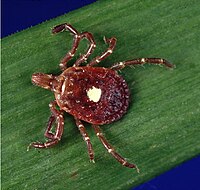
Photo from wikipedia
Dogs are known to host several tick-borne pathogens with zoonotic potential; however, scant information is available on the epidemiology of these pathogens in low-income tropical countries and in particular in… Click to show full abstract
Dogs are known to host several tick-borne pathogens with zoonotic potential; however, scant information is available on the epidemiology of these pathogens in low-income tropical countries and in particular in sub-Saharan Africa. With the aim of investigating a wide range of tick-borne pathogens (i.e., Rickettsia spp., Anaplasma spp., Erhlichia spp., Borrelia spp., Hepatozoon spp. and Babesia spp.), 273 blood samples were collected from dogs in selected districts of Ethiopia and analyzed by real-time and/or end-point PCR. The results of the study showed that Hepatozoon canis was the most prevalent pathogen (53.8%), followed by Anaplasma phagocythophilum (7.0%), Babesia canis rossi (3.3%), Ehrlichia canis (2.6%) and Anaplasma platys (2.2%). Furthermore, five samples tested positive for Borrelia spp., identified as Borrelia afzelii (n = 3) and Borrelia burgdorferi (n = 2), and two samples for Rickettsia spp., identified as Rickettsia conorii (n = 1) and Rickettsia monacensis (n = 1). The finding of Anaplasma phagocythophilum and different species of the genera Borrelia and Rickettsia with zoonotic potential was unexpected and alarming, and calls for further investigation on the roles of dogs and on the tick, species acting as vector in this specific context. Other pathogens (Hepatozoon canis, Babaesia canis rossi, Anaplasma platys, Ehrlichia canis) are already known to have an important impact on the dogs’ health but have minor zoonotic potential as they were rarely or never reported in humans. Dogs from rural areas were found to be at higher risk for different pathogens, probably due to the presence of other wild canids in the same environment. The findings of the present study contribute to a better knowledge of the epidemiology of tick-borne pathogens, which is relevant to human and animal health.
Journal Title: Tropical Medicine and Infectious Disease
Year Published: 2023
Link to full text (if available)
Share on Social Media: Sign Up to like & get
recommendations!